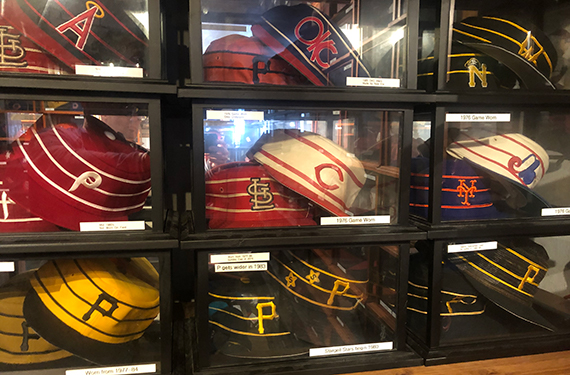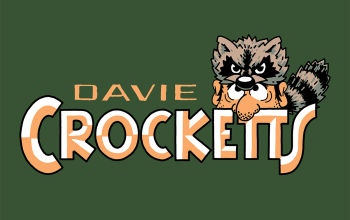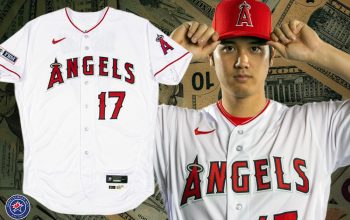
“Andy from Pennsylvania” has a collection of baseball caps that has earned attention from curious strangers who travel from out of state to see it, the History Channel, local media, and minor league teams that have invited him to display it during games. He has been collecting baseball caps of all sorts—NFL, college, Cub Scouts, Little League—for more than four decades, but one particular aspect of his collection holds a special place in his heart.
“Authentic MLB and MiLB caps are the only caps that I have saved and still collect to this day,” he said. “To me the authentic cap that professional baseball players wear on the field is sacred.”

Andy is so dedicated to his collection that when he attends games, he carries hundreds of dollars, not just to spend in the team store, but in case he sees a fellow fan wearing a hat that he wants to purchase. At least two caps have found a home in his collection this way: Williamsport Crosscutters and Washington Nationals.
“I have embarrassed my wife on many occasions by talking complete strangers into selling me the cap they are—were—wearing on their head at the time,” he said. “My wife gets nervous when she is with me and we see someone wearing an authentic cap, because I’m going to want to look at the underbrim, the button, the logo, and speak to the stranger about it.

Most collectors can tell you exactly how many items they have in their collection at any given moment, but Andy’s focus is not on numbers, it’s on quality. His wife knows that he wants to be buried in his favorite, a 1994 “Bad Luck Blue” cap, which the Phillies stopped wearing because they kept losing in them.
Andy’s focus is on hats that were fabricated prior to 2017 for a couple reasons. The MLB caps have lost their luster “mostly because of the highly offensive New Era flag that appears on the side,” he said, and for the Minor League caps, it’s because they “are now made in Vietnam or Bangladesh and are simply unwearable because of the fit and the materials.”
Andy’s collection started in the late 1970s, when New Era and KM Pro advertised their caps in sports magazines—Andy has some of original ads framed in his office. The cap collection is a natural extension of his early love for baseball cards and logos. He took notice when teams made even subtle changes to their uniforms or caps. Uniforms were too expensive and hard to find, so he started collecting caps the caps.

“By looking at baseball cards, you could see the differences in the logos and length of brims, which meant that different companies were making the caps being worn by the players,” he said. “My first memory of this was probably the 1976 St. Louis Cardinals, where you could see players wearing a grey and then other players wearing a green undervisor on the pillbox cap.”
Speaking of pillbox caps, Andy has one of each of the six teams who wore them in 1976—the Pirates, Reds, Cardinals, Expos, Mets, and Phillies (pictured at the top of this post).

Andy takes notice of the minor changes that teams make. He spent the summer of 1986 wearing a Mets cap that had a green undervisor, but when the Mets played in the World Series that year, they switched to caps with grey underbrims.
“This was earth shattering for me,” Andy said, “and I can only compare it to the first time I saw a woman naked.”
On the other side of the emotional spectrum, a betrayal by New Era led to a similar loss of innocence.
“Remember the 1995 Cincinnati Reds with the pinstripe caps?” he asked. “Beautiful caps…but New Era did not sell to consumers the exact cap that the Reds were wearing. When I realized this, I can only compare it to the realization that Santa Claus was a big fake.”

While it may seem that this collection is something of an emotional roller coaster, these minor changes have kept Andy interested over the years. The 1998 Cardinals alternate cap has a red beak, which changed to yellow thereafter. In 1997 the Mets switched to an orange button on the top of the cap. (“Terrible!”) And most blasphemous of all in Andy’s opinion is what the Milwaukee Brewers did to their iconic MB glove logo in the 2020 season: They added another layer of stitching to the baseball.
“This is unforgivable,” Andy said. “The original logo was created by Tom Meindel, a college student in 1977, and his original has one row of stitching on the baseball. Makes me angry just thinking about this, I wish I could bleach my eyes.”

Andy wears only a few of the caps in his collection on regular basis, including a 1976 KM Pro Cincinnati Reds as well as an early 1970s Phillies cap made by Wilson. Most of his hats remain on display in what Andy’s wife calls his “hatatorium,” a room full of caps in display cases. Hats in the “hatatorium” are grouped by manufacturer: vintage New Era, Wilson, Roman Pro, McAuliffe, and KM Pro, with additional groups for MiLb caps and another for pillbox and umpire caps.
You can learn more about Andy’s ever-growing collecting on his blog, Tip-of-the-Cap.com, and on Twitter at @paandy188.









